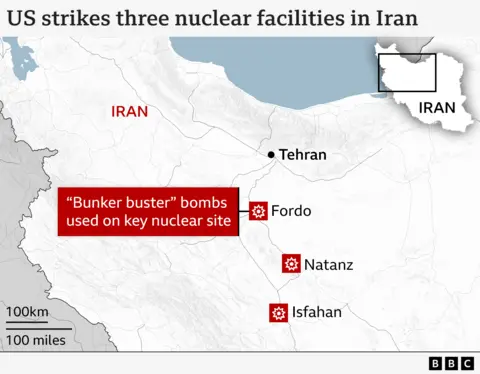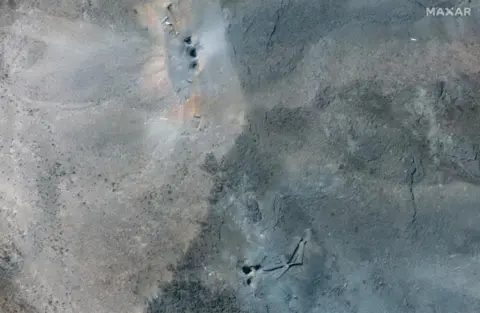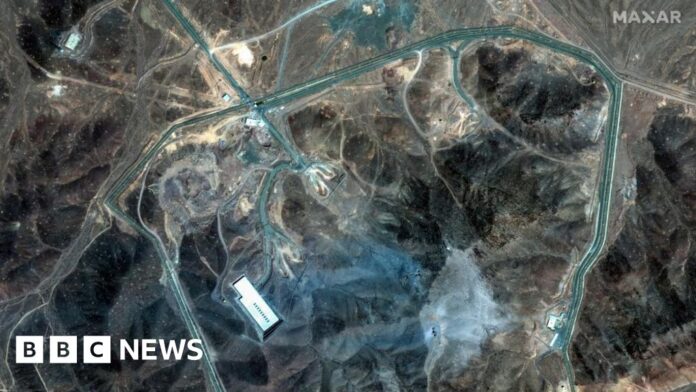BBC News


President Donald Trump says the US has carried out a “successful” bombing attack on three nuclear sites in Iran and they have been “obliterated”.
Israel says they were in “full co-ordination” with the US in planning the strikes. Iranian officials have confirmed the facilities were struck but denied it had suffered a major blow.
The strikes mark a significant escalation in the ongoing war between Iran and Israel.
Here’s what we know.
What has the US bombed, and what weapons did it use?
US Gen Dan Caine, chairman of the joint chiefs of staff, said Operation Midnight Hammer involved 125 US military aircraft including seven B-2 stealth bombers.
Three nuclear facilities were targeted – Fordo, Natanz and Isfahan, the US said.
During a Pentagon briefing, Caine said bombers set off from the US on an 18-hour flight, with some heading west into the Pacific as a “decoy”, while the main strike package made up of the seven B-2 bombers proceeded into Iran.
Just before the aircraft entered Iranian airspace, more than two dozen Tomahawk cruise missiles were launched from a US submarine at targets at the Isfahan site, he said.
As the bombers entered Iranian airspace, the US deployed “several deception tactics, including decoys,” with fighter jets clearing the airspace ahead of them, checking for enemy aircraft and surface-to-air missiles, Caine said.
The lead B-2 then dropped two GBU-57 Massive Ordnance Penetrators (MOPs) – also known as “bunker buster” bombs – on the nuclear site at Fordo. Caine said a total of 14 MOPs were dropped on two target areas.
All three Iranian nuclear infrastructure targets were hit between 18:40 Eastern time (23:40 BST) and 19:05 Eastern time (00:05 BST), Caine said.
The bombers then exited Iranian airspace and begun their return to the US.
“Iran’s fighters did not fly, and it appears that Iran’s surface-to-air missile systems did not see us,” Caine said.
Speaking at the same briefing, Defence Secretary Pete Hegseth said the operation did not target Iranian troops or the Iranian people.
He added that the mission “was not, and has not been about regime change”.
The defence secretary said he recognised “our allies in Israel” for the support given, adding that the operations took months and weeks of planning.


Hidden away in a remote mountainside, Fordo nuclear site includes a uranium enrichment plant that is vital to Iran’s nuclear ambitions.
Located south of Tehran, it is believed to be deeper underground than the Channel Tunnel connecting the UK and France.
Due to Fordo’s depth below ground only the US has the kind of “bunker buster” bomb big enough to penetrate the site.
It weighs 13,000kg (30,000lb) and is able to drop through about 18m (60ft) of concrete or 61m (200ft) of earth before exploding, according to experts.
Due to the depths of Fordo’s tunnels, the MOP is not guaranteed to be successful, but it is the only bomb that could come close.
Caine confirmed that between the seven B-2 Spirit bombers, 14 MOP bombs were among “75 precision-guided weapons” used in the strikes against Iran.


What is known about the impact of the attacks?
Gen Caine has said it will take some time to fully assess the extent of the damage caused by the US attack.
But, he said, “an initial battle damage assessment indicates that all three sites sustained extremely severe damage and destruction”.
New satellite imagery taken on 22 June shows six fresh craters at the Fordo nuclear site, likely the entry points for US munitions, as well as grey dust and debris scattered down the mountainside.


Following the US’s confirmation that MOPs were used in the attack, senior imagery analyst at McKenzie Intelligence Services, Stu Ray, told BBC Verify: “You will not see a huge blast effect at the entry point as it is not designed to detonate on entry but deeper down into the facility.”
He added that it looks like three separate munitions were dropped on two separate impact points, and that the grey colouration on the ground appears to show concrete debris blown out by the explosions.
Ray also said the tunnel entrances appear to have been blocked off. As there are no visible craters or impact points near them, he suggests this may have been an Iranian attempt to “mitigate against deliberate targeting of the entrances by aerial bombardment”.
The Iranian Atomic Energy Organization said the bombing of the three nuclear sites was a “barbaric violation” of international law.
Both Saudi Arabia and the UN’s nuclear watchdog the International Atomic Energy Agency (IAEA) say there has been no increase in radiation levels after the attack.
The deputy political director of Iran’s state broadcaster, Hassan Abedini, said Iran had evacuated these three nuclear sites a “while ago”. Appearing on state-run TV, he said Iran “didn’t suffer a major blow because the materials had already been taken out”.
How might Iran retaliate?
Within the hours of the US bombing, Iran launched a fresh barrage of missiles which hit parts of Tel Aviv and Haifa. At least 86 people were injured, officials said.
Iran’s Foreign Minister Abbas Araqchi condemned the US strike and said Tehran reserved the right to respond. He said Trump had “betrayed” Americans who had been promised an end to US involvement in Middle East wars.
BBC security correspondent Frank Gardner says Iran must now choose between three strategic courses of action in response to the US attack overnight:
- Do nothing. This could spare it from further US attacks. It could even choose the diplomatic route and re-join negotiations with the US. But doing nothing makes the Iranian regime look weak, especially after all its warnings of dire repercussions if the US did attack. It may decide the risk of weakening its grip on its population outweighs the cost of further US attacks
- Retaliate hard and fast. Iran still has a substantial arsenal of ballistic missiles after manufacturing and hiding these away for years. It has a target list of around 20 US bases to choose from in the broader Middle East. It could also launch “swarm attacks” on US Navy warships using drones and fast torpedo boats
- Retaliate later at a time of its own choosing. This would mean waiting until the current tension has subsided and launching a surprise attack when US bases were no longer on maximum alert
What did Donald Trump say and how have US politicians reacted?
Posting on his Truth Social platform at 19:50 local time (00:50 BST), Trump confirmed the strikes on Fordo, Natanz, and Isfahan.
Just over two hours later and flanked by Vice-President JD Vance, Defence Secretary Hegseth and Secretary of State Marco Rubio, Trump made a televised address.
He said that future attacks would be “far greater” unless Iran reached a diplomatic solution.
“Remember, there are many targets left,” he said.
Several members of Trump’s Republican Party have posted statements in support of the move, including Texas Senator Ted Cruz who “commended” the president.
Not every Republican was as supportive, with leading Trump backer Congresswoman Marjorie Taylor Greene saying “this is not our fight”.
Leading US Democrat Hakeem Jeffries said Trump risked US “entanglement in a potentially disastrous war in the Middle East”, while others have accused him of bypassing Congress to launch a new war.
Independent Senator Bernie Sanders described the US strikes as “grossly unconstitutional” as the president does not have the sole power to formally declare war on another country. Only Congress – lawmakers elected in the House of Representatives and the Senate – can.
But the law also states that the president is the commander in chief of the armed forces. That means he can deploy US troops and conduct military operations without a formal declaration of war.
How have world leaders reacted?
UK Prime Minister Sir Keir Starmer said the US took action to “alleviate” what he called the “grave threat” posed by Iran’s nuclear programme. In a statement, he called on Tehran to agree to talks and reach a diplomatic solution.
UN secretary general António Guterres said the US air strikes were a dangerous escalation; while European Union foreign policy chief Kaja Kallas urged all sides to step back and return to the negotiating table.
Saudi Arabia has voiced “great concern” while Oman condemned the strikes and called for de-escalation.
Indian Prime Minister Narendra Modi said he had spoken to Iranian President Masoud Pezeshkian and called for “dialogue and diplomacy as the way forward”.
Russian politician Dmitry Medvedev, an ally of President Vladimir Putin, said: “Trump, who came in as a peacemaker president, has started a new war for the US. With this kind of success, Trump won’t win the Nobel Peace Prize”.
How did this start?
Israel launched a surprise attack on dozens of Iranian nuclear and military targets on 13 June. It said its ambition was to dismantle its nuclear programme, which Prime Minister Benjamin Netanyahu said would soon be able to produce a nuclear bomb.
Iran insists its nuclear ambitions are peaceful. In retaliation, Tehran launched hundreds of rockets and drones at Israel. The two countries have continued exchanging strikes since, in an air war which has now lasted more than a week.
Trump has long said that he is opposed to Iran possessing a nuclear weapon. Israel is widely believed to have them, although it neither confirms nor denies this.
In March, US national intelligence director Tulsi Gabbard said that while Iran had increased its uranium stockpile to unprecedented levels, it was not building a nuclear weapon – an assessment Trump recently said was “wrong”.
On the campaign trail, Trump had criticised past US administrations for engaging in “stupid endless wars” in the Middle East, and he vowed to keep America out of foreign conflicts.
The US and Iran were in nuclear talks at the time of Israel’s surprise attack. Only two days ago, Trump said he would give Iran two weeks to enter into substantial negotiations before striking – but that timeline turned out to be much shorter.




